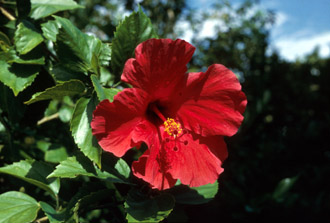Nutrition
The Hibiscus rosa-sinensis is an
autotroph, meaning it produces its own food. The plant receives
its food through a process called photosynthesis. Photosynthesis
is where the plant uptakes carbon dioxide and water and changes
it into glucose and oxygen.
 The plant uses carbon dioxide and
water as fuel to help maintain cellular processes within the
plant. Humans benefit from the byproducts of photosynthesis.
Humans use the byproducts of photosynthesis to fuel our own
energy needs.
The plant uses carbon dioxide and
water as fuel to help maintain cellular processes within the
plant. Humans benefit from the byproducts of photosynthesis.
Humans use the byproducts of photosynthesis to fuel our own
energy needs.
The Hibiscus rosa-sinensis can live in a variety of different soil types. The plant can tolerate soils that are highly acidic, semi-alkaline, clay, sand, and loam. The Hibiscus rosa-sinensis prefers temperatures that are above 56 degrees Fahrenheit.
 The
Hibiscus rosa-sinensis serves as a host to the fungus
Canker. If there are fruiting bodies on the
stems of the plant, it can kill just those stems of the plant or
it can kill the entire plant. The plant can also be infected by
blight which kills off the flowers. The plant uses nitrogen, potassium, and phosphorus to grow. The nutrients of nitrogen,
potassium, and phosphorus are distributed by the xylem and
phloem vascular tissues in the plant. Food in the plant is
stored as starch in the plant.
The
Hibiscus rosa-sinensis serves as a host to the fungus
Canker. If there are fruiting bodies on the
stems of the plant, it can kill just those stems of the plant or
it can kill the entire plant. The plant can also be infected by
blight which kills off the flowers. The plant uses nitrogen, potassium, and phosphorus to grow. The nutrients of nitrogen,
potassium, and phosphorus are distributed by the xylem and
phloem vascular tissues in the plant. Food in the plant is
stored as starch in the plant.
To visit reproduction page click here!
To return home click here!